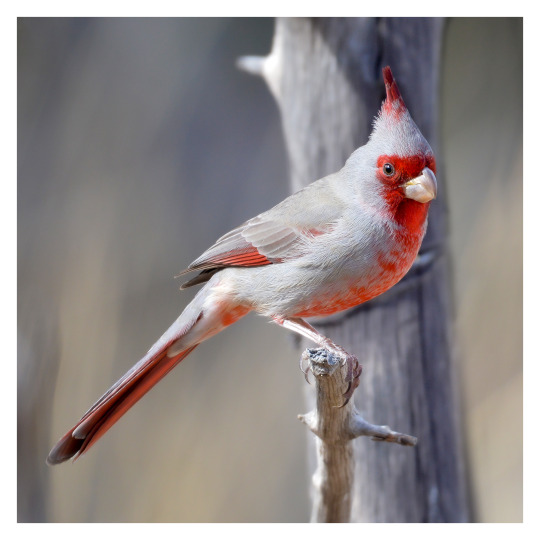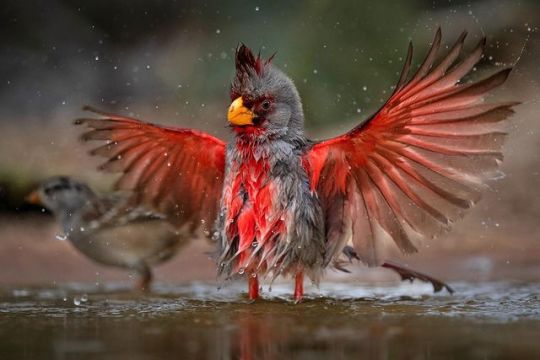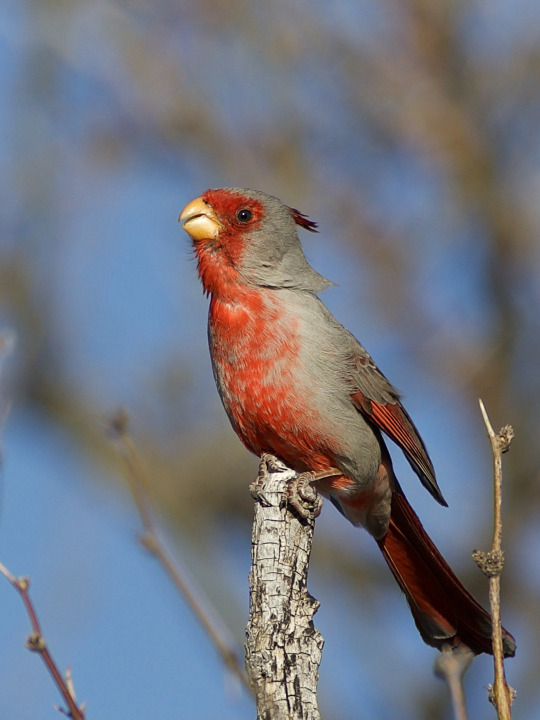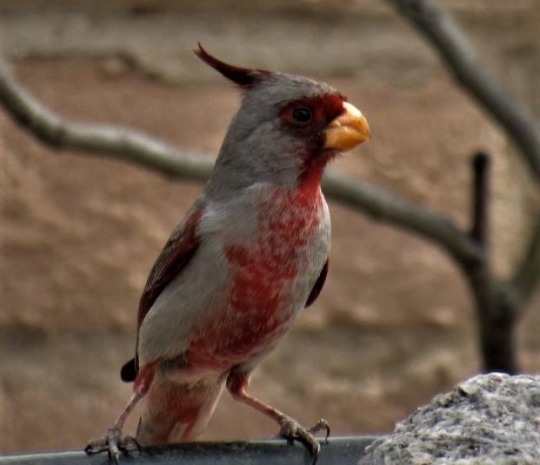#Cardinalis sinuatus
Explore tagged Tumblr posts
Text

#575, a pyrrhuloxia! These birds along with stellar's jays fascinated me when looking through our big animal guide books. I've seen the jays now but looking forward to seeing one of these!
Requests for birds are open, updates happen on Thursdays. [project tag] | [kofi]
89 notes
·
View notes
Photo

Pyrrhuloxia (Cardinalis sinuatus)
© Félix Cloutier
65 notes
·
View notes
Photo

Recent birds: pyrrhuloxia / cardenal desértico (Cardinalis sinuatus).
At Ash Canyon Bird Sanctuary, Cochise County, Arizona.
#photographers on tumblr#pyrrhuloxia#Cardinalis sinuatus#bird#birding#Ash Canyon Bird Sanctuary#Southeastern Arizona Bird Observatory#Cochise County#Arizona
231 notes
·
View notes
Text

Pyrrhuloxia
#pyrrhuloxia#desert cardinal#cardinal#Cardinalis sinuatus#Passeriformes#Cardinalidae#Cardinalis#bird#upl
87 notes
·
View notes
Note
🥚 (have a cardnial in these voiltile times)



Your northern cardinal and my pyrrhuloxia (Cardinalis sinuatus) should be cardinal besties
37 notes
·
View notes
Text

Pyrrhuloxia (Cardinalis sinuatus), male, and Northern Cardinal (Cardinalis cardinalis), male, family Cardinalidae, order Passeriformes, Texas, USA
Photograph by Jeff Clow
#cardinal#pyrrhuloxia#cardinalis#cardinalidae#passeriformes#bird#ornithology#animals#nature#north america
3K notes
·
View notes
Text

Pyrrhuloxia (Cardinalis sinuatus), J-Six Ranch, Cochise County, Arizona.
865 notes
·
View notes
Text

Pyrrhuloxia aka Desert Cardinal (Cardinalis sinuatus), family Cardinalidae, order Passeriformes, Laguna Atascosa National Wildlife Refuge, south Texas, USA
Photograph by Steve Sinclair
6 notes
·
View notes
Text

Female pyrrhuloxia (Cardinalis sinuatus)
Saguaro National Park, Arizona, USA
O’odham Jeweḍ, Sobaipuri, Tohono O’odham, and Hohokam land
#original photography#wildlife photography#photographers on tumblr#nature photography#ornithology#hiking#winter#desert#arizona#saguaro national park
34 notes
·
View notes
Text

A desert bird
it is Autumn on garden earth but simultaneously Spring
[Organ Pipe Cactus National Monument]
Ever seen a silver cardinal?
The beautiful Pyrrhuloxia (Cardinalis sinuatus) has a slightly difficult name to pronounce (PURR-huu-lox-i-a) but we don't mind. Perhaps because of its slightly tongue-twistery name (and its appearance), it's also known as the "desert cardinal". Use whichever you prefer; we're pretty sure this silver and red bird doesn't mind one way or another (but you might want to ask it just to be polite)!
To learn more about birds in the monument, visit
11.19.23 • Facebook
when you read these instrumental words you see inside the heart of my thought-life, the inner space of silence
And you are free to allow them in, to communicate with my inner voice
(my heart & spirit)
writing in lines just as a poem, just like an ancient psalm that is read (although it is music, albeit silent in nature since contained “documented” in a Book long before recording music was even possible on garden earth)
And so we see the ancient writing of Scripture as a living body of work that “breathes…” (in Spirit)
and my spirit gently “mirrors” this, writing in lines just as (the inner rings) of a Tree
but my heart also reaches out in music, just as the sounds heard on earth in its True nature “instrumentally speaking”
like birdsong
(the inner silence) of a book as its heart is like the night sky… painted with words (as stars)
this is the inner room (the instrumental womb of thought)
And even the starry night sky plays music in praise of our beautiful mysterious Creator
The Holy One asks, “Do you really think you can find
someone or something to compare to Me? My equal?”
Look at the myriad of stars and constellations above you.
Who set them to burning, each in its place?
Who knows those countless lights each by name?
They obediently shine, each in its place,
because God has the great strength and strong power to make it so.
The Book (Scroll) of Isaiah, Chapter 40:25-26 (The Voice)
It is I who made the very ground on which you stand,
I who shaped the human beings who walk around on it.
I pulled the sky and the heavens taut with My own hands,
and organized the army of stars that march across the night sky.
The Book (Scroll) of Isaiah, Chapter 45:12 (The Voice)
Can you bind together a cluster of twinkling stars—
the seven sisters of Pleiades who keep company in the night sky?
Can you loosen the cords of Orion’s bow?
Can you lead the stars of the Zodiac out in their proper seasons
and guide the Bear with her cubs?
Do you know the rules of the heavens,
or apportion their influence on the seasons of the earth?
The Book of Job, Chapter 38:31-33 (The Voice)
When I gaze to the skies and meditate on Your creation—
on the moon, stars, and all You have made,
I can’t help but wonder why You care about mortals—
sons and daughters of men—
specks of dust floating about the cosmos.
But You placed the son of man just beneath God
and honored him like royalty, crowning him with glory and honor.
You ordained him to govern the works of Your hands,
to nurture the offspring of Your divine imagination;
You placed everything on earth beneath his feet:
All kinds of domesticated animals,
even the wild animals in the fields and forests,
The birds of the sky and the fish of the sea,
all the multitudes of living things that travel the currents of the oceans.
O Eternal, our Lord,
Your majestic name is heard throughout the earth.
The Book of Psalms, Poem 8:3-9 (The Voice)
The unfathomable cosmos came into being at the word of the Eternal’s imagination, a solitary voice in endless darkness.
The breath of His mouth whispered the sea of stars into existence.
The Book of Psalms, Poem 33:6 (The Voice)
He counts all the stars within His hands,
carefully fixing their number
and giving them names.
The Book of Psalms, Poem 147:4 (The Voice)
[Psalm 148]
Praise the Eternal!
All you in the heavens, praise the Eternal;
praise Him from the highest places!
All you, His messengers and His armies in heaven:
praise Him!
Sun, moon, and all you brilliant stars above:
praise Him!
Highest heavens and all you waters above the heavens:
praise Him!
Let all things join together in a concert of praise to the name of the Eternal,
for He gave the command and they were created.
He put them in their places to stay forever—
He declared it so, and it is final.
Everything on earth, join in and praise the Eternal;
sea monsters and creatures of the deep,
Lightning and hail, snow and foggy mists,
violent winds all respond to His command.
Mountains and hills,
fruit trees and cedar forests,
All you animals both wild and tame,
reptiles and birds who take flight:
praise the Lord.
All kings and all nations,
princes and all judges of the earth,
All people, young men and women,
old men and children alike,
praise the Lord.
Let them all praise the name of the Eternal!
For His name stands alone above all others.
His glory shines greater than anything above or below.
He has made His people strong;
He is the praise of all who are godly,
the praise of the children of Israel, those whom He holds close.
Praise the Eternal!
The Book of Psalms, Poem 148 (The Voice)
we are those at the time of the “end”:
“Those who are wise will shine as bright as the sky at midday, and those who make the many righteous will shine as the stars forever and ever. As for you, Daniel, keep these visions and their meaning a secret. Write down what you have seen and heard, then seal the scroll until the time of the end. Many will wander here and there, and knowledge will expand.”
The Book of Daniel, Chapter 12:3-4 (The Voice)
(will you take it all to heart?)
And your heart is sealed, like a secret, yet only until you willingly choose to “unveil” it to my eyes
to come to share (the inner space) of your thought-life with mine
to first meet from a distance, becoming friends.
to have an inner conversation before bodies meet.
speaking with me in silence but also “mirrored” by your voice from your body of garden earth and time
in the shape of your (silence & sound)
(are you content to wait to hear me speak until seeing me in body? would you still be willing to speak to the heart & spirit of a book in the meantime? and will you read & write in thought with its words?)
everything has to be presented as a question mark (?)
2 notes
·
View notes
Photo

Pyrrhuloxia (Cardinalis sinuatus)
© Jack Kelly
3 notes
·
View notes
Photo

Pyrrhuloxia (Cardinalis sinuatus) male, Texas
Photographer: Alan Murphy / BIA



11 notes
·
View notes
Text
Cardinalis

Northern Cardinal by Hari Krishnan, CC BY-SA 4.0
Etymology: Bishop
First Described By: Bonaparte, 1838
Classification: Dinosauromorpha, Dinosauriformes, Dracohors, Dinosauria, Saurischia, Eusaurischia, Theropoda, Neotheropoda, Averostra, Tetanurae, Orionides, Avetheropoda, Coelurosauria, Tyrannoraptora, Maniraptoromorpha, Maniraptoriformes, Maniraptora, Pennaraptora, Paraves, Eumaniraptora, Averaptora, Avialae, Euavialae, Avebrevicauda, Pygostaylia, Ornithothoraces, Euornithes, Ornithuromorpha, Ornithurae, Neornithes, Neognathae, Neoaves, Inopinaves, Telluraves, Australaves, Eufalconimorphae, Psittacopasserae, Passeriformes, Eupasseres, Passeri, Euoscines, Passerides, Core Passerides, Passerida, Passerid Clade, Cardinalidae
Referred Species: C. cardinalis (Northern Cardinal), C. sinuatus (Desert Cardinal, the Pyrrhuloxia), C. phoeniceus (Vermilion Cardinal)
Status: Extant, Least Concern
Time and Place: Within the last 10,000 years; in the Holocene of the Quaternary


The Cardinals are known mainly from most of North America, as well as isolated spots along the northern coast of South America

Physical Description: The Cardinals are a trio of extremely well known, red-colored songibrds, sporting distinctive pointy crests and short, squat beaks. They have medium-length, skinny tails and usually a black patch around the eyes. The males are the bright red sex in all species, ranging from completely red all over to having red patches around the eyes, on the crest, wings, and on the belly. The females are always much more dull, with brown coloration and some red patches - especially on the crest and wings. They range in size from 19 to 23 centimeters, making them fairly middle of the road in terms of overall body size among songbirds. The juveniles are similar to the females in appearance, and only differentiate to bright red or not upon reaching sexual maturity. Each species has a noticeable pointy crest, which varies in height, angle, and sharpness depending on species and sex. In short, spotting a species of Cardinal is quiet easy, as they are all extremely distinctive in appearance.
Diet: The cardinals are classic omnivores, though they seem to prefer plant material such as leaves, fruits, and seeds to animal remains; though they are known to feed on insects and larvae. They do visit bird feeders.

Pyrrhuloxia by Langhorne Copernicus Clemens, CC BY-SA 3.0
Behavior: Cardinals will forage, primarily alone, in a variety of open and forest habitats; they do form loose flocks when it is not the breeding season, but during breeding time they will only associate with their mate to feed. While they will move about based on food and water availability, as well as availability of nesting habitat, these birds do not migrate extensively.
The Northern Cardinal is known to mate for life, and stay with their mate year-round. It is presumed that similar behaviors are observed by the other two species of cardinal, however it has not been studied extensively in either case. The nests are made out of cups of vegetation and twigs, which are usually placed in brush and bushes rather than in trees, fairly close to the ground and concealed by foliage. The clutch can range in size from one to five eggs, but usually there are two to three eggs. The young are brooded mostly by the female, while the male brings her food for about two weeks. Both parents then guard and care for the young for the next two days until they fledge.

Vermillion Cardinal by Mathdesm, in the Public Domain
These birds make very distinct calls and songs, and both sexes will sing in these species. The Northern Cardinal will even sing together as mated pairs. They make wheet-wheet-wit-wit-wit-wit calls, or other series of whistles, and the species that overlap in range with one another will even start trying to sing over each other with their varying calls. These songs are pleasant to listen to, as they are very melodic and sweet. They sing throughout the year and throughout the day, though females sing slightly less often than males - mainly, females sing while nesting, leading to the male coming back to the nest with food. They will also call in alarm, with very short, sharp chips to warn of the approach of predators.
These birds do not migrate during winter and fluff up their down feathers in order to trap warm air and keep themselves comfortable during snowy times, and even have hair-like feathers underneath the downy layer to aid in keeping warm. Their feet are very scaly and small and thus vulnerable to cold temperatures, so they’ll tuck their feet up into their down one at a time to keep them warm.

Northern Cardinal by Ken Thomas, in the Public Domain
These birds are not particularly shy or afraid of humans and are oftentimes easily spotted - between their commonness and coloration - by birders. They do approach human dwellings and feeders and will only fly away upon too close of an approach by the human in question.
While the ranges of the Pyrrhuloxia and the Northern Cardinal do overlap extensively, they do not appear to come into conflict with one another.
Ecosystem: These birds live in semi-open habitats, preferring to roost in brushes, shrubs, and small trees. They have been found in abandoned farmland and extensively in suburbs. They also are found often in arid brushland and along rivers, but they can get water from their food sources as well and do not need to rely on the rivers to drink. The Northern Cardinal is the victim of brood parasitism - where other kinds of birds will lay their eggs in the nests of the Cardinal - mainly by the Brown-Headed Cowbird. The Pyrrhuloxia is also parasitized by the Brown-Headed Cowbird, but in addition it can be the victim of parasitism by the Bronzed Cowbird. Northern Cardinals are preyed upon by a variety of birds including falcons, hawks, shrikes, eagles, and owls; the bright red color does not make it easy for them to hide. Their eggs can be fed upon by snakes, jays, squirrels, chipmunks, and of course, the evil domestic cat.

Pyrrhuloxia by Liftarn, CC BY-SA 4.0
Other: Cardinals are protected under the Migratory Species Act and, though they used to be kept as pet, are now illegal to be kept in such a way.
Species Differences: The Northern Cardinal lives in the most northward habitats and are the most common of the three species, with distinctively bright red males and still reddish females. The Pyrrhuloxia is more associated with southern and desert habitats in North America, and the males are not fully red like the Northern Cardinal. The Vermillion Cardinal is easily told apart from the other two, even though it looks very similar to the Northern Cardinal, because its range is extremely far away - it is only found in patches along the northern coast of South America, a good distance away from the other cardinals.
~ By Meig Dickson
Sources under the cut
Brewer, D. (2019). Northern Cardinal (Cardinalis cardinalis). In: del Hoyo, J., Elliott, A., Sargatal, J., Christie, D.A. & de Juana, E. (eds.). Handbook of the Birds of the World Alive. Lynx Edicions, Barcelona.
Brewer, D. (2019). Pyrrhuloxia (Cardinalis sinuatus). In: del Hoyo, J., Elliott, A., Sargatal, J., Christie, D.A. & de Juana, E. (eds.). Handbook of the Birds of the World Alive. Lynx Edicions, Barcelona.
Brewer, D. (2019). Vermilion Cardinal (Cardinalis phoeniceus). In: del Hoyo, J., Elliott, A., Sargatal, J., Christie, D.A. & de Juana, E. (eds.). Handbook of the Birds of the World Alive. Lynx Edicions, Barcelona.
Jobling, J. A. 2010. The Helm Dictionary of Scientific Bird Names. Christopher Helm Publishing, A&C Black Publishers Ltd, London.
Tough Little Birds. How Do Birds Keep Warm?
#cardinal#cardinalis#bird#dinosaur#songbird#songbird saturday & sunday#birds#dinosaurs#birblr#northern cardinal#pyrrhuloxia#desert cardinal#vermilion cardinal#cardinalis sinuatus#cardinalis cardinalis#cardinalis phoeniceus#north america#south america#omnivore#quaternary#factfile#biology#a dinosaur a day#a-dinosaur-a-day#dinosaur of the day#dinosaur-of-the-day#science#nature
122 notes
·
View notes
Photo

Ms. P.
Pyrrhuloxia / cardenal desértico (Cardinalis sinuatus), at Ash Canyon Bird Sanctuary, Cochise County, Arizona.
#photographers on tumblr#pyrrhuloxia#Cardinalis sinuatus#bird#birding#Ash Canyon Bird Sanctuary#Southeastern Arizona Bird Observatory#Cochise County#Arizona
158 notes
·
View notes
Photo

Pyrrhuloxia
134 notes
·
View notes
Photo

Pyrrhuloxia in Bob Rodrigues’ yard
27 notes
·
View notes